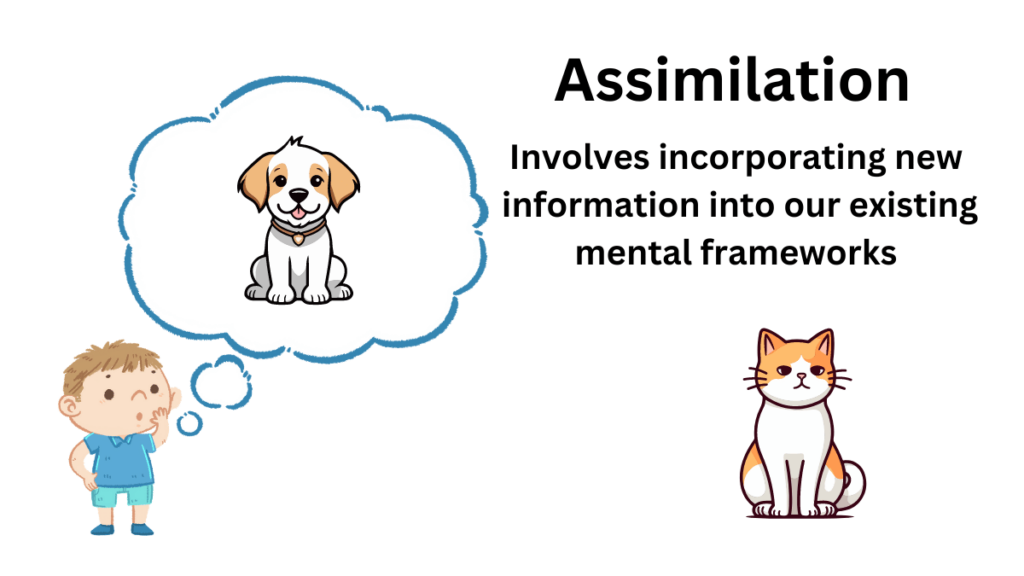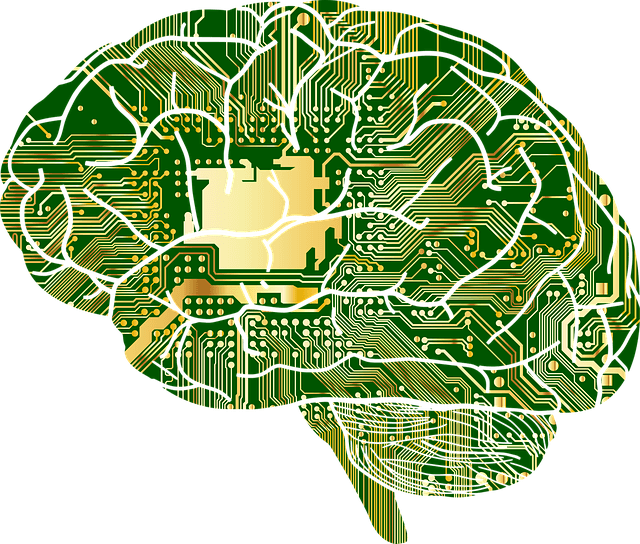Assimilation in Psychology: Definition and Examples
Assimilation in psychology explains how we integrate new experiences into existing frameworks, shaping how we learn, adapt, and view the world around us.

Assimilation in psychology is the process of fitting new information into what we already know and understand. Imagine putting a puzzle piece into an existing puzzle – that’s similar to how our minds use assimilation to make sense of new experiences.
When you see a new type of dog you’ve never encountered before, your brain automatically fits it into your existing understanding of what dogs are like. This is different from accommodation, where we have to change our understanding to match new information that doesn’t fit our current knowledge.

Jean Piaget, a famous psychologist who studied how children learn and develop, discovered that our minds use both assimilation and accommodation to understand the world around us. These processes work together through mental frameworks called schemas, which are like filing cabinets in our brains that store information about different concepts, objects, and experiences.
What Is Psychological Assimilation?
Picture your mind as a huge collection of mental folders, each containing information about different things you know. Psychological assimilation is how you file new information into these existing folders without creating new ones. For example, when you meet a friendly golden retriever, your brain automatically files this experience into your existing “dogs are friendly pets” folder.
This mental filing system was first described by Jean Piaget, a child development expert who noticed how children learn about their world. He found that our brains use two main processes: assimilation and accommodation. While assimilation is like filing new information into existing folders, accommodation happens when we need to create new folders or change our old ones because the information doesn’t quite fit.
Here’s how assimilation works in everyday life:
- When you learn that dolphins are mammals (not fish), you add this to your existing understanding of mammals
- If you taste a new fruit that’s sweet, you connect it to your previous experiences with sweet foods
- When you learn a new word in English, you link it to your existing knowledge of similar words
Assimilation helps us make quick sense of new experiences by connecting them to what we already know. However, sometimes new information doesn’t fit neatly into our existing understanding – that’s when we need accommodation instead.
Assimilation vs. Accommodation: How Our Minds Process New Information
Think of your mind as a library. Assimilation is like putting a new book on an existing shelf because it fits the category. Accommodation, however, is when you need to build a whole new shelf because the book doesn’t fit anywhere else.

How Assimilation Works
When a young child first sees a zebra, they might call it a horse because it fits their existing understanding of four-legged animals with long faces and tails. They’re using assimilation – fitting new information into what they already know.
How Accommodation Works
Later, when this same child learns that zebras have unique striped patterns and live in different places than horses, they need to create a new mental category for zebras. This is accommodation – adjusting their thinking to make room for new information that doesn’t quite fit their old understanding.
Key Differences
Assimilation keeps your existing understanding and adds to it, like adding more fish to your “sea creatures” category. Accommodation changes your understanding or creates new categories, like realizing that whales need their own category because they’re mammals, not fish.
Things work best when both processes work together. Sometimes we can simply add new information to what we know (assimilation), and other times we need to change our thinking entirely (accommodation). Both processes are essential for how we learn and grow.
Jean Piaget’s View on Assimilation

Jean Piaget was a Swiss psychologist who played a significant role in the study of cognitive development and the concept of assimilation.
Piaget believed that assimilation is a fundamental process in which individuals incorporate new information into their existing mental frameworks or schemas. According to Piaget, assimilation allows individuals to make sense of the world by relating new experiences to their pre-existing knowledge.
Piaget’s view on assimilation emphasized the importance of active learning and the role of schemas. He proposed that individuals have mental structures called schemas, which are frameworks that organize and interpret information. These schemas are developed through experiences and interactions with the environment.
Piaget argued that when individuals encounter new information that can be easily assimilated into their existing schemas, they assimilate it without much cognitive effort.
However, if the new information does not fit into their existing schemas, they experience a state of disequilibrium known as cognitive dissonance. This state motivates individuals to modify their existing schemas or create new ones through accommodation.
In Piaget’s view, assimilation and accommodation work together to promote cognitive development. Through assimilation, individuals expand their existing knowledge and understanding, while accommodation allows for the creation of new knowledge and the adaptation to new experiences.

Piaget’s view on assimilation highlights its crucial role in cognitive development and the construction of knowledge. By incorporating new information into existing schemas, individuals can make sense of the world and continue to grow intellectually.
Real-World Examples of Assimilation
Psychological assimilation can be observed in various situations and contexts.
In Your Daily Life
Think about how you react when you taste a new food. If it’s sweet and creamy like ice cream, your brain might automatically file it under “desserts” – that’s assimilation at work. Your mind uses what you already know about desserts to understand this new experience.
In Child Development
Watch a toddler playing with new objects and you’ll see assimilation in action. When a child first sees a tablet computer, they might try to press it like their favorite toy buttons or swipe it like they’ve seen grown-ups do. They’re using their existing knowledge about toys and buttons to understand this new device.
In Language Learning
When English speakers learn Spanish, they often pronounce “mesa” (table) like “mess-ah” instead of “may-sah.” They’re assimilating the new word into their English pronunciation patterns. Similarly, they might say “I am hungry” in Spanish word-for-word (Yo soy hambriento) instead of the correct “Tengo hambre,” because they’re fitting Spanish into English grammar patterns.
In Professional Settings
New employees often assimilate workplace information based on their previous jobs. A former restaurant server working in retail might automatically tell customers “enjoy your meal” after a purchase – they’re using their existing customer service script in a new context.
In Social Media
When people first used TikTok, many treated it like YouTube, expecting longer videos and different types of content. They were assimilating this new platform into their existing understanding of video-sharing sites.
Why These Examples Matter
Understanding how we assimilate information helps us recognize when we might need to adjust our thinking instead. Sometimes assimilation works perfectly – like understanding a new fruit is edible because it’s in the produce section. Other times, we need to create new mental categories to truly understand something new.
The Role of Schemas in Assimilation
Schemas play a crucial role in the process of assimilation in psychology. A schema can be defined as a mental framework or structure that helps individuals organize and interpret new information based on their existing knowledge and experiences.
When encountering new information, individuals tend to assimilate it by fitting it into their existing schemas. Schemas act as filters through which individuals perceive and make sense of the world around them.
They provide a framework for understanding and categorizing new experiences, objects, or ideas.
For example, let’s consider a child who has a schema for birds. When the child sees a new bird with bright colors and a long beak, they may assimilate it into their existing schema for birds. This assimilation allows the child to make sense of the new bird based on their previous knowledge of birds.
However, schemas can also lead to biases and limitations in assimilation. Individuals with rigid or narrow schemas may struggle to incorporate new information that does not fit within their existing framework. This can result in resistance to change or a tendency to dismiss contradictory information.
Summary
Assimilation in psychology refers to the process by which individuals incorporate new information into their existing knowledge and understanding. It involves fitting new experiences, objects, or ideas into pre-existing mental frameworks called schemas. Schemas act as filters through which individuals perceive and make sense of the world around them.
Assimilation differs from accommodation, which involves modifying existing schemas or creating new ones to incorporate new information that cannot be assimilated. While assimilation allows individuals to make sense of new information based on their existing knowledge, accommodation enables them to adapt and expand their understanding.
Jean Piaget emphasized the importance of assimilation in cognitive development. He believed that assimilation and accommodation work together to shape individuals’ understanding of the world and promote intellectual growth.
Examples of assimilation can be seen in everyday life. For instance, a child with a schema for dogs may assimilate a new breed of dog into their existing schema. This allows them to recognize the new dog as a variation of what they already know.
By understanding the role of schemas and the distinction between assimilation and accommodation, we can gain insights into how individuals learn, develop, and navigate their psychological experiences.
Sources:
Gebhardt, S., Grant, P., von Georgi, R., & Huber, M. T. (2008). Aspects of Piaget’s cognitive developmental psychology and neurobiology of psychotic disorders – An integrative model. Medical Hypotheses, 71(3), 426–433. https://doi.org/10.1016/j.mehy.2008.03.042
Leipold, B., Bermeitinger, C., Greve, W., Meyer, B., Arnold, M., & Pielniok, M. (2014). Short-term induction of assimilation and accommodation. Quarterly Journal of Experimental Psychology, 67(12), 2392–2408. https://doi.org/10.1080/17470218.2014.931443





